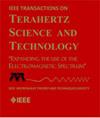8×8 Patch-Antenna-Coupled TeraFET Detector Array for Terahertz Quantum-Cascade-Laser Applications
IF 3.9
2区 工程技术
Q2 ENGINEERING, ELECTRICAL & ELECTRONIC
IEEE Transactions on Terahertz Science and Technology
Pub Date : 2024-08-05
DOI:10.1109/TTHZ.2024.3438429
引用次数: 0
Abstract
Monolithically integrated, antenna-coupled field-effect transistors (TeraFETs) are rapid and sensitive detectors for the terahertz range (0.3–10 THz) that can operate at room temperature. We conducted experimental characterizations of a singlepatch-antenna-coupled TeraFET optimized for 3.4 THz operation and its integration into an 8×8 multielement detector configuration. In this configuration, the entire TeraFET array operates as a unified detector element, combining the output signals of all detector elements. Both detectors were realized using a mature commercial Si-CMOS 65-nm process node. Our experimental characterization employed single-mode quantum-cascade lasers (QCLs) emitting at 2.85 and 3.4 THz. The 8×8 multielement detector yields two major improvements for sensitive power detection experiments. First, the larger detector area simplifies alignment and enhances signal stability. Second, the reduced detector impedance enabled the implementation of a TeraFET+QCL system capable of providing a -3 dB modulation bandwidth up to 21 MHz, which is currently limited primarily by the chosen readout circuitry. Finally, we validate the system's performance by providing high-resolution gas spectroscopy data for methanol vapor around 3.4 THz, where a detection limit of用于太赫兹量子级联激光应用的 8×8 贴片天线耦合 TeraFET 检测器阵列
单片集成的天线耦合场效应晶体管(TeraFET)是太赫兹范围(0.3-10 太赫兹)的快速灵敏探测器,可在室温下工作。我们对单片天线耦合 TeraFET 进行了实验表征,该 TeraFET 针对 3.4 THz 工作频率进行了优化,并将其集成到 8×8 多元素探测器配置中。在这种配置中,整个 TeraFET 阵列作为一个统一的探测器元件运行,将所有探测器元件的输出信号组合在一起。这两个探测器都是利用成熟的商用 Si-CMOS 65 纳米工艺节点实现的。我们的实验表征采用了发射频率为 2.85 和 3.4 太赫兹的单模量子级联激光器 (QCL)。8×8 多元素探测器为灵敏功率检测实验带来了两大改进。首先,更大的探测器面积简化了对准过程并增强了信号稳定性。其次,探测器阻抗的减小使得 TeraFET+QCL 系统能够提供高达 21 MHz 的 -3 dB 调制带宽,而这一带宽目前主要受限于所选的读出电路。最后,我们通过提供 3.4 THz 附近甲醇蒸汽的高分辨率气体光谱数据验证了该系统的性能。\text{molecules}/\text{cm}^{3}$。
本文章由计算机程序翻译,如有差异,请以英文原文为准。
求助全文
约1分钟内获得全文
求助全文
来源期刊

IEEE Transactions on Terahertz Science and Technology
ENGINEERING, ELECTRICAL & ELECTRONIC-OPTICS
CiteScore
7.10
自引率
9.40%
发文量
102
期刊介绍:
IEEE Transactions on Terahertz Science and Technology focuses on original research on Terahertz theory, techniques, and applications as they relate to components, devices, circuits, and systems involving the generation, transmission, and detection of Terahertz waves.
 求助内容:
求助内容: 应助结果提醒方式:
应助结果提醒方式:


